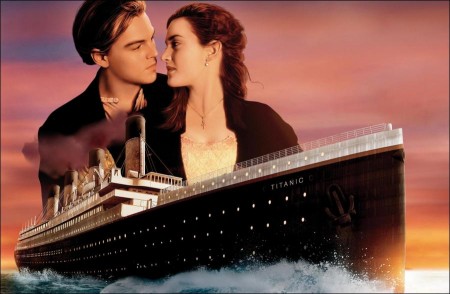Titanic 3D: A Brief History. Through the combined efforts of Cameron’s filmmaking team and consultants Don Lynch and Ken Marschall, Titanic was willed into reality, captivating us for a second time this century. As for its first incarnation in 1912, the ship was constructed in Belfast during a pressured two-year period, taking yet a third year to outfit. Motivated by White Star Line’s competitive campaign and thanks to the new achievements in communication, Titanic was launched with an unprecedented wave of worldwide publicity.
Titanic left Southampton dock midday on Wednesday, April 10, 1912, stopping at Cherbourg, France, where the “unsinkable” Molly Brown and John Jacob Astor, the wealthiest of Titanic’s prestigious passengers, boarded and, finally, made her last stop at Queenstown on the south coast of Ireland. From Queenstown, with some 2,223 people aboard, she steamed at top speed for New York City.
Yet, despite repeated warnings of ice along its route, the ship fatally struck an iceberg at 11:40pm on April 14, less than five days into its maiden voyage. By 2:30am on April 15th, she lay torn in half at the bottom of the North Atlantic.
“Titanic didn’t just ‘sink,'” explains executive producer Rae Sanchini, commenting on the ship’s final hours. “She literally ripped in two at the surface, with over 250 feet of stern lifting out of water and, at one point, stood nearly vertical to the ocean’s surface. Her dramatic death throes lived up to her pretentious name. The maiden voyage of the ‘ship of dreams’ ended in a nightmare truly beyond comprehension.”
“In addition to being the greatest disaster story ever told, the brief life and stunning death of Titanic is a landmark historic event. In a sense, it signaled the end of the age of innocence, shattered confidence in progress and technology, and challenged passive acceptance of class as a definition of birthright. Survival on Titanic,” Sanchini points out, “was a direct function of class and gender.”
A fateful combination of events transpired during Titanic’s brief journey, each placing the floating city on a collision course with infamy. Erroneous decisions in navigation, communication gaps, the absence of emergency procedures, the lack of adequate lifeboats, the ingrained privilege of upper-class, the fierce cold, the moonless dark, the sheer physics of what happened to the Titanic, disbelief and denial, all contributed to the deaths of 1,500 men, women and children in a lethally cold sea. Even if they were able to have survived the sinking, they soon succumbed to hypothermia in water four degrees below freezing.
The final hours of Titanic continue to be analyzed today, with experts, scientists and laymen tirelessly perusing the well-known and conflicting information about the event. Ironically, the social consequences of this event seem to remain in the distance.
Cameron observes, “Titanic was the first big wake-up call of the twentieth century. Technology had been delivering a steady diet of miracles for the better part of two decades — the automobile, sound recording, radio communication, the airplane, motion pictures. Everything was just exploding with possibilities; it was all going to be great and wonderful in the never-ending upward spiral of progress. And then, boom — 15 hundred people die in what had been advertised as the best, safest, most luxurious ship ever built. Our so-called mastery over nature was completely refuted and forever destroyed.”
Related Link: View the Full Production Notes for Titanic 3D
Views: 141



